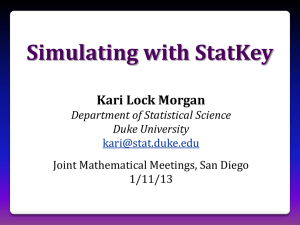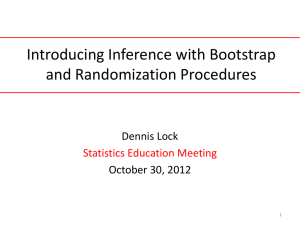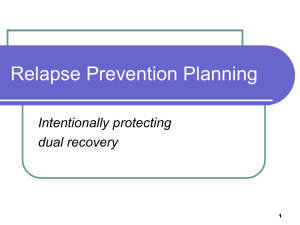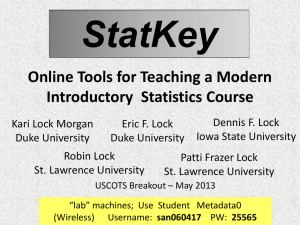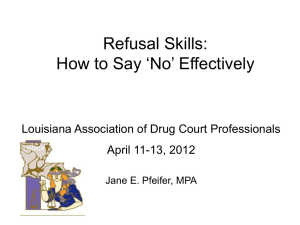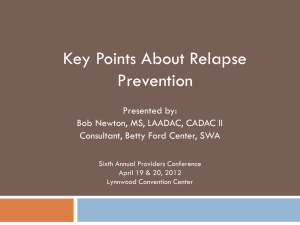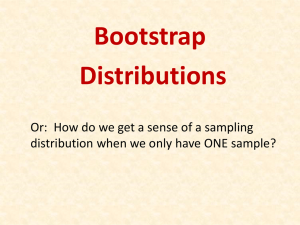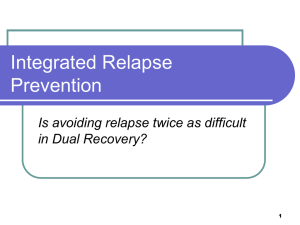R - Unlocking the Power of Data
advertisement
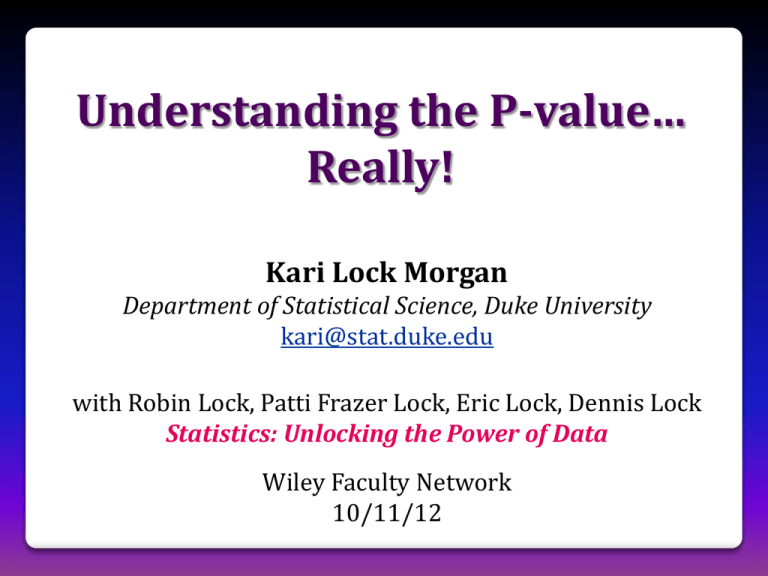
Understanding the P-value… Really! Kari Lock Morgan Department of Statistical Science, Duke University kari@stat.duke.edu with Robin Lock, Patti Frazer Lock, Eric Lock, Dennis Lock Statistics: Unlocking the Power of Data Wiley Faculty Network 10/11/12 Mind-Set Matters • 84 hotel maids recruited • Half were randomly selected to be informed that their work satisfies recommendations for an active lifestyle • After 8 weeks, the informed group had lost 1.59 more pounds, on average, than the control group • Did the information actually cause them to lose more weight, or might we see a difference this extreme just by random chance??? Crum, A.J. and Langer, E.J. (2007). “Mind-Set Matters: Exercise and the Placebo Effect,” Psychological Science, 18:165-171. Traditional Inference 1. Which formula? X1 X 2 s12 s22 n1 n2 4. Which theoretical distribution? 5. df? 6. find p-value 0.005 < p-value < 0.01 2. Calculate numbers and plug into formula 0.2 (1.79) 2.322 2.882 34 41 3. Plug into calculator 2.65 > pt(2.65, 33, lower.tail=FALSE) [1] 0.006130769 Traditional Inference • Confidence intervals and hypothesis tests using the normal and t-distributions • With a different formula for each situation, students often get mired in the details and fail to see the big picture • Plugging numbers into formulas does little to help reinforce conceptual understanding Simulation Methods • Simulation methods (bootstrapping and randomization) are a computationally intensive alternative to the traditional approach • Rather than relying on theoretical distributions for specific test statistics, we can directly simulate the distribution of any statistic • Great for conceptual understanding! Hypothesis Testing To generate a distribution assuming H0 is true: •Traditional Approach: Calculate a test statistic which should follow a known distribution if the null hypothesis is true (under some conditions) • Randomization Approach: Decide on a statistic of interest. Simulate many randomizations assuming the null hypothesis is true, and calculate this statistic for each randomization Paul the Octopus http://www.youtube.com/watch?v=3ESGpRUMj9E Paul the Octopus • Paul the Octopus predicted 8 World Cup games, and predicted them all correctly • Is this evidence that Paul actually has psychic powers? • How unusual would this be if he was just randomly guessing (with a 50% chance of guessing correctly)? • How could we figure this out? Simulate with Students • Students each flip a coin 8 times, and count the number of heads • Count the number of students with all 8 heads by a show of hands (will probably be 0) • If Paul was just guessing, it would be very unlikely for him to get all 8 correct! • How unlikely? Simulate many times!!! Simulate with StatKey www.lock5stat.com/statkey 12 8 0.0039 Cocaine Addiction • In a randomized experiment on treating cocaine addiction, 48 people were randomly assigned to take either Desipramine (a new drug), or Lithium (an existing drug) • The outcome variable is whether or not a patient relapsed • Is Desipramine significantly better than Lithium at treating cocaine addiction? R R R R R R R R R R R R R R R R R R R R R R R R R R R R R R R R R R R R R R R R R R R R R R R R 1. Randomly assign units to treatment groups New Drug R R R R Old Drug R R R R R R R R R R R R R R R R R R R R R R R R R R R R R R R R R R R R R R R R 2. Conduct experiment 3. Observe relapse counts in each group R = Relapse N = No Relapse 1. Randomly assign units to treatment groups New Drug Old Drug R R R R R R pˆ new pˆ old R R R R R R R R R R N R N R R R R R R R N R N R N N N N R R R R R R N N N N N N 10 18 24 24 .333 N N N N N N 10 relapse, 14 no relapse 18 relapse, 6 no relapse Randomization Test • Assume the null hypothesis is true • Simulate new randomizations • For each, calculate the statistic of interest • Find the proportion of these simulated statistics that are as extreme as your observed statistic R R R R R R R R R R R R R R R R N N R R R R R R N N N N N N R R R R R R N N N N N N N N N N N N 10 relapse, 14 no relapse 18 relapse, 6 no relapse R R R R R R R R R R R R R R R R N N R R R R R R N N N N N N R R R R R R N N N N N N N N N N N N Simulate another randomization New Drug Old Drug R N R N R R R R R R R N R R R N R N N N R R 16 relapse, 8 no relapse pˆ N pˆ O 16 12 24 24 0.167 N N N R N R R N N N N R N R R N R N R R R R 12 relapse, 12 no relapse Simulate another randomization New Drug Old Drug R R R R R R R N R R N N R R N R N R R N R N R R 17 relapse, 7 no relapse pˆ N pˆ O 17 11 24 24 0.250 R R R R R R R R R R R R R R R R R R N N N N N N 11 relapse, 13 no relapse Simulate with Students • Give students index cards labeled R (28 cards) and N (20 cards) • Have them deal the cards into 2 groups • Compute the difference in proportions • Contribute to a class dotplot for the randomization distribution Cocaine Addiction You want to know what would happen • Why did you re-deal your cards? • by random chance (the random allocation to treatment groups) • Why did you leave the outcomes (relapse or no relapse) unchanged on each card? • if the null hypothesis is true (there is no difference between the drugs) Simulate with StatKey www.lock5stat.com/statkey Distribution of Statistic Assuming Null is True Proportion as extreme as observed statistic observed statistic The probability of getting results as extreme or more extreme than those observed if the null hypothesis is true, is about .02. p-value Mind-Set Matters • 84 hotel maids recruited • Half were randomly selected to be informed that their work satisfies recommendations for an active lifestyle • After 8 weeks, the informed group had lost 1.59 more pounds, on average, than the control group • Did the information actually cause them to lose more weight, or might we see a difference this extreme just by random chance??? Crum, A.J. and Langer, E.J. (2007). “Mind-Set Matters: Exercise and the Placebo Effect,” Psychological Science, 18:165-171. Simulation Approach ACTUAL Non-Informed 0.4 -3.0 0.8 -1.6 -2.8 … Informed 2.6 -5.4 -0.8 2.0 -9.6 … Difference in means: 1.59 SIMULATED Non-Informed 0.4 -3.0 0.8 -2.8 2.6 -5.4 2.0 -9.6 2.0 … Informed -3.0 0.8 -1.6 -2.8 2.6 -0.8 -5.4 -9.6 -0.8 … Difference in means: -0.47 Difference in means: 0.32 StatKey www.lock5stat.com/statkey Distribution of Statistic by random chance, if H0 true Proportion as extreme as observed statistic p-value observed statistic Traditional Inference 1. Which formula? X1 X 2 s12 s22 n1 n2 4. Which theoretical distribution? 5. df? 6. find p-value 0.005 < p-value < 0.01 2. Calculate numbers and plug into formula 0.2 (1.79) 2.322 2.882 34 41 3. Plug into calculator 2.65 > pt(2.65, 33, lower.tail=FALSE) [1] 0.006130769 Mind-Set and Weight Loss The Conclusion! The results seen in the experiment are very unlikely to happen just by random chance (just 6 out of 1000!) We have strong evidence that the information actually caused the informed maids to lose more weight! In other words, MIND-SET MATTERS! Simulation vs Traditional • Simulation methods • intrinsically connected to concepts • same procedure applies to all statistics • no conditions to check • minimal background knowledge needed • Traditional methods (normal and t based) • familiarity expected after intro stats • needed for future statistics classes • only summary statistics are needed • insight from standard error Simulation AND Traditional? • Our book introduces inference with simulation methods, then covers the traditional methods • Students have seen the normal distribution appear repeatedly via simulation; use this common shape to motivate traditional inference • “Shortcut” formulas give the standard error, avoiding the need for thousands of simulations • Students already know the concepts, so can go relatively fast through the mechanics Topics Ch 1: Collecting Data Ch 2: Describing Data Ch 3: Confidence Intervals (Bootstrap) Ch 4: Hypothesis Tests (Randomization) Ch 5: Normal Distribution Ch 6: Inference for Means and Proportions (formulas and theory) Ch 7: Chi-Square Tests Ch 8: ANOVA Ch 9: Regression Ch 10: Multiple Regression (Optional): Probability Theoretical Approach • Normal and t-based inference after bootstrapping and randomization: • Students have seen the normal distribution repeatedly – CLT easy! • Same idea, just using formula for SE and comparing to theoretical distribution • Can go very quickly through this! Theoretical Approach www.lock5stat.com/statkey p-value t-statistic Chi-Square and ANOVA • Introduce new statistic - 2 or F • Students know that these can be compared to either a randomization distribution or a theoretical distribution • Students are comfortable using either method, and see the connection! • If conditions are met, the randomization and theoretical distributions are the same! Chi-Square Statistic Randomization Distribution p-value = 0.357 Chi-Square Distribution (3 df) 2 statistic = 3.242 p-value = 0.356 2 statistic = 3.242 Student Preferences Which way of doing inference gave you a better conceptual understanding of confidence intervals and hypothesis tests? Bootstrapping and Formulas and Randomization Theoretical Distributions 113 69% 51 31% Student Preferences Which way did you prefer to learn inference (confidence intervals and hypothesis tests)? Bootstrapping and Formulas and Randomization Theoretical Distributions 105 64% 60 36% Simulation Traditional AP Stat 31 36 No AP Stat 74 24 Student Behavior • Students were given data on the second midterm and asked to compute a confidence interval for the mean • How they created the interval: Bootstrapping t.test in R Formula 94 84% 9 8% 9 8% A Student Comment " I took AP Stat in high school and I got a 5. It was mainly all equations, and I had no idea of the theory behind any of what I was doing. Statkey and bootstrapping really made me understand the concepts I was learning, as opposed to just being able to just spit them out on an exam.” - one of my students It is the way of the past… "Actually, the statistician does not carry out this very simple and very tedious process [the randomization test], but his conclusions have no justification beyond the fact that they agree with those which could have been arrived at by this elementary method." -- Sir R. A. Fisher, 1936 … and the way of the future “... the consensus curriculum is still an unwitting prisoner of history. What we teach is largely the technical machinery of numerical approximations based on the normal distribution and its many subsidiary cogs. This machinery was once necessary, because the conceptually simpler alternative based on permutations was computationally beyond our reach. Before computers statisticians had no choice. These days we have no excuse. Randomization-based inference makes a direct connection between data production and the logic of inference that deserves to be at the core of every introductory course.” -- Professor George Cobb, 2007 Book Statistics: Unlocking the Power of Data Robin H. Lock, St. Lawrence University Patti Frazer Lock, St. Lawrence University Kari Lock Morgan, Duke University Eric F. Lock, Duke University Dennis F. Lock, Iowa State To be published November 2012 kari@stat.duke.edu
